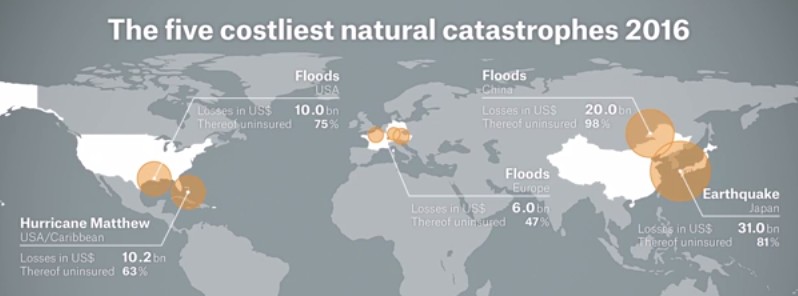Natural catastrophe losses in 2016 at their highest since 2012

According to Munich RE, a global reinsurance company, after three years of relatively low natural catastrophe losses, the 'figures for 2016 are back in the mid-range, where they are expected to be.' In terms of casualties, 2016 had the fewest fatalities (after 2014) since 1986.
A number of devastating earthquakes and powerful storms made 2016 the costliest twelve months for natural catastrophe losses in the last four years, the company said. Losses totaled US$ 175 billion, a good two-thirds more than in the previous year, and very nearly as high as the figure for 2012 (US$ 180 billion).
While the year saw a two-thirds increase in the financial impact of catastrophes, the number of casualties from natural disasters were far lower in 2016 than in 2015, with some 8 700 deaths compared with 25 400. This is within the ten-year average of 60 600 but it makes 2016 the year with fewest fatalities (after 2014 with 8 050) in 30 years, since 1986 with 8 600.
The high number of flood events, including river flooding and flash floods, was exceptional and accounted for 34% of overall losses, compared with an average of 21% over the past ten years.
The most devastating natural events in 2016, in terms of financial loss, were two earthquakes on the Japanese island of Kyushu in April (US$ 31 billion) and floods in China in June and July (US$ 20 billion). Hurricane "Matthew" in October was third, at $10.2 billion.
“After three years of relatively low natural catastrophe losses, the figures for 2016 are back in the mid-range, where they are expected to be. Losses in a single year are obviously random and cannot be seen as a trend,” said a member of the Board of Management Torsten Jeworrek.

With 160 events recorded, North America was hit by more loss occurrences in 2016 than in any other year since 1980. The year’s most serious event here was Hurricane Matthew. Its greatest impact was in the Caribbean island nation of Haiti, which was still struggling to recover from the 2010 earthquake.
North America was also impacted by other extreme weather hazards, including wildfires in the Canadian town of Fort McMurray in May, and major floods in the southern US states in summer. In Canada, the mild winter with less snow than usual, and the spring heatwaves and droughts which followed, were the principal causes of the devastating wildfires that hit the oil-sand-producing region of Alberta, generating overall losses of US$ 4 billion.
There was a series of storms in Europe in late May and early June. Torrential rain triggered numerous flash floods, particularly in Germany, and there was major flooding on the River Seine in and around Paris. Overall losses totaled some US$ 6bn (approximately €5.4bn), around half of which was insured.
“A look at the weather-related catastrophes of 2016 shows the potential effects of unchecked climate change. Of course, individual events themselves can never be attributed directly to climate change. But there are now many indications that certain events – such as persistent weather systems or storms bringing torrential rain and hail – are more likely to occur in certain regions as a result of climate change”, explained Peter Höppe, Head of Munich Re’s Geo Risks Research Unit.
Source: Munich RE
Featured image credit: Munich Re

Surely the earthquake in Ecuador (spring 2016) is high in the ranking. Why is there no mention of that?